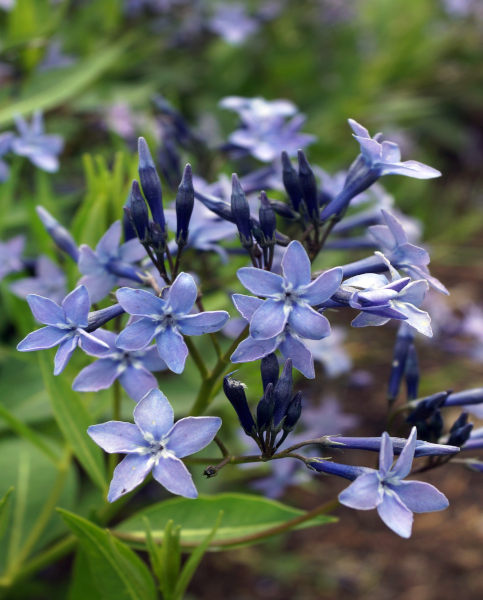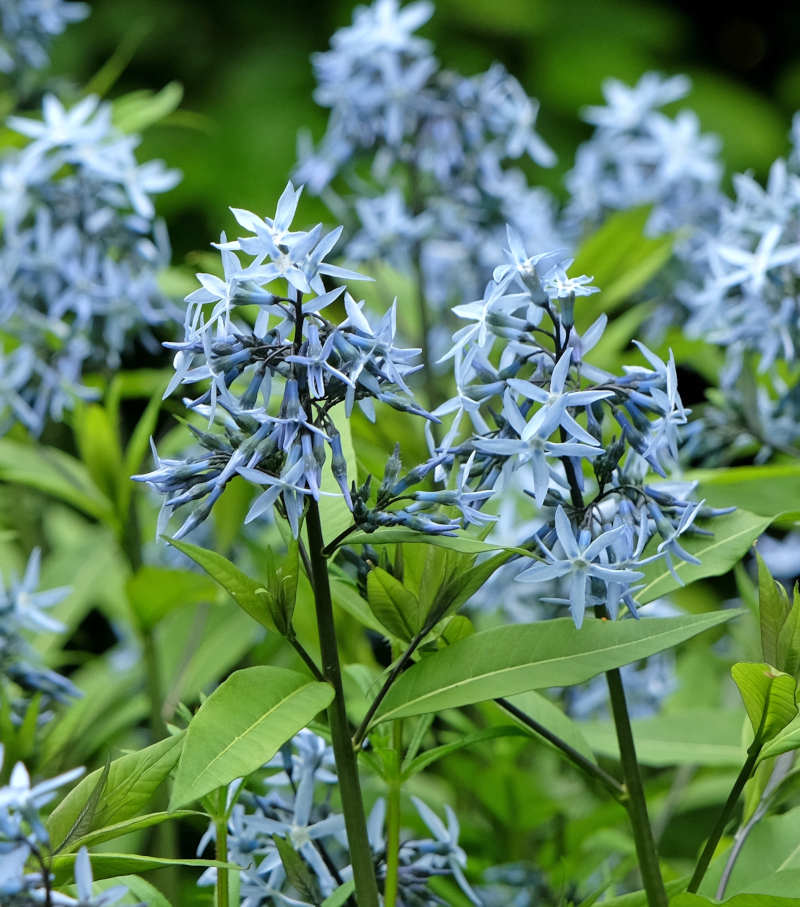How to grow Amsonia
A clump-forming, herbaceous perennial with vibrant blue, star-shaped flowers from June-July each year. Grows to a height of 30cm with a spread of 60cm and likes a moist, well-drained soil in part sun, part shade that benefits from a degree of shelter. Amsonia will also tolerate full shade and is loved by pollinators and wildlife. Great for naturalising and container growing. Plant out in spring or autumn at the same height in the soil as it is in the pot, firm and water well. Can be propagated by division after flowers are spent in autumn. Fully hardy to -10°c (although containers are more vulnerable) and great as a cut flower for your home too.

Key Information
Soil pH
Position
Hardiness


Where & when to plant Amsonia
Amsonia, otherwise known as Blue Star, grows best in fertile, moist soil which is well-drained. A sunny aspect is best for this clump-forming perennial which can tolerate some shade too. As a drought-tolerant plant once established, Amsonia is great for gravel gardens and prairie-style planting schemes.
The starry pastel-blue blooms add a magical sparkle to summer borders, so plant where they will be seen and appreciated near the front. Plants can take a year or two to establish and will reach an eventual height of up to 50cm once mature. The stems will grow tougher if grown in a sunny spot and less likely to bend or topple under the weight of the flowers. Try to plant in a sheltered spot for protection from strong winds.
The leaves and stems of Amsonia exude a milky sap when broken off which can irritate skin – so always wear gloves when handling and pruning.
Amsonia is best planted in spring or autumn which allows the roots to settle in before flowering in June and July.
How to plant Amsonia
Plant in groups for the best effect and space plants at least 50cm apart to allow room to mature and spread. Each plant will form a tidy clump of foliage.
Using a hand trowel or small spade, dig a hole slightly wider and deeper than the pot which your plant is sitting in. If you garden on heavy soil, amend the planting site first by incorporating some horticultural grit to the area and dig it in thoroughly so the roots will have adequate drainage.
Next, add a thick layer of organic matter in the form of homemade compost, well-rotted manure, or leaf-mould. Place the young plant into the hole after carefully teasing it from its pot.
Fill in around the edges of your plant with garden soil and firm into place before watering well. Ensure you keep young plants watered regularly until they have established themselves, especially if the weather is dry.

What to plant with Amsonia
Amsonia pairs well with Ornamental grasses such as Festuca glauca Elijah Blue, Miscanthus sinensis Sirene, Pennisetum Little Honey, and Carex oshimensis Evergold.
Groups of Amsonia add a wonderful dimension to a gravel garden or prairie-style planting scheme with plants from a similar colour palette such as Alliums, Agapanthus, Stachys, Veronica, Dutch Iris, and Perovskia.
Please contact our friendly and knowledgeable Customer Care Team at Hayloft if you would like any further help or planting ideas for your Amsonia plants. We will be more than happy to help.



How to care for Amsonia
Water young plants regularly whilst they are settling in. Amsonia is a drought tolerant plant and should not require further watering once established. Pot grown plants will require additional watering during very dry or hot weather as free-draining containers can dry out very quickly.
There is no need to deadhead the blooms after flowering. The seedpods left behind can be an attractive feature in the autumn garden.
The foliage turns yellow or orange in autumn and adds colour to the borders. Once it starts to fade in winter, prune plants back to at least half their size to encourage fresh new growth.
Apply a layer of mulch around the base of plants in autumn after pruning in the form of leaf-mould or homemade compost to add nutrients to the soil.
Bring pot-grown plants undercover and place either in an unheated greenhouse, polytunnel, or covered cold frame for winter protection. Although Amsonia is hardy, the roots of pot-grown plants are more susceptible to frost damage.
How to propagate Amsonia
Amsonia plants can be divided in spring once mature. This will not only maintain the vigour of your plants but will increase your stock for planting in other parts of the garden or for sharing with friends and family.
If you are planning to replant new sections of Amsonia straight away, dig new planting holes and add organic matter and grit as before. Or, have pots with gritty compost at hand ready to plant the divisions into.
Dig around your plant with a spade or garden fork, slightly wider than the visible growth and remove the whole clump. Separate the plant into several smaller sections by using two forks back-to-back in the centre of the mass and pulling them apart.
Plant your new divisions into their holes or pots and water well until established.
Amsonia can also be grown from seed in February and March, taking typically 4-6 weeks to germinate at 13-15°C. Sow fresh seed in trays of seed compost and lightly cover with a fine layer of compost of vermiculite. Water the trays from the bottom to avoid washing away seeds and place them in an unheated greenhouse, cold-frame, or windowsill to germinate.
Once your seedlings they have formed at least two sets of leaves, prick each one out and pot on into individual pots or modules filled with multipurpose compost which has been sieved to remove any large lumps. Grow the seedlings on and harden off before planting outside after the final frosts (usually the end of May for the UK).
Hardening off involves bringing plants outside during the daytime and moving back undercover for the night for around 2 weeks.




